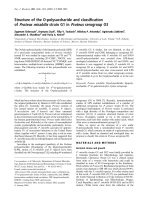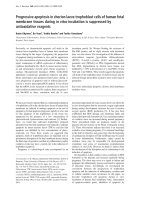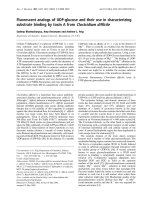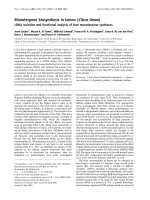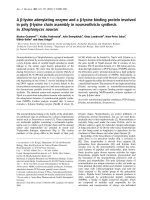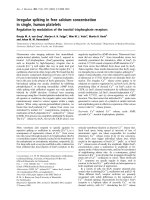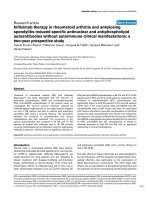Báo cáo y học: "Supply-demand balance in outward-directed networks and Kleiber''''s law" pot
Bạn đang xem bản rút gọn của tài liệu. Xem và tải ngay bản đầy đủ của tài liệu tại đây (254.65 KB, 7 trang )
BioMed Central
Page 1 of 7
(page number not for citation purposes)
Theoretical Biology and Medical
Modelling
Open Access
Research
Supply-demand balance in outward-directed networks and Kleiber's
law
Page R Painter*
Address: Office of Environmental Health Hazard Assessment, California Environmental Protection, Agency, P.O. Box 4010, Sacramento CA 95812,
USA
Email: Page R Painter* -
* Corresponding author
nutrient supply networksallometric scalingmetabolism
Abstract
Background: Recent theories have attempted to derive the value of the exponent α in the
allometric formula for scaling of basal metabolic rate from the properties of distribution network
models for arteries and capillaries. It has recently been stated that a basic theorem relating the sum
of nutrient currents to the specific nutrient uptake rate, together with a relationship claimed to be
required in order to match nutrient supply to nutrient demand in 3-dimensional outward-directed
networks, leads to Kleiber's law (b = 3/4).
Methods: The validity of the supply-demand matching principle and the assumptions required to
prove the basic theorem are assessed. The supply-demand principle is evaluated by examining the
supply term and the demand term in outward-directed lattice models of nutrient and water
distribution systems and by applying the principle to fractal-like models of mammalian arterial
systems.
Results: Application of the supply-demand principle to bifurcating fractal-like networks that are
outward-directed does not predict 3/4-power scaling, and evaluation of water distribution system
models shows that the matching principle does not match supply to demand in such systems.
Furthermore, proof of the basic theorem is shown to require that the covariance of nutrient uptake
and current path length is 0, an assumption unlikely to be true in mammalian arterial systems.
Conclusion: The supply-demand matching principle does not lead to a satisfactory explanation for
the approximately 3/4-power scaling of mammalian basal metabolic rate.
Introduction
Regression analyses of measurements of a physiological or
structural variable R (e.g. cardiac output or pulmonary
alveolar surface area) in mammals of different mass M
have shown in many cases that the variable is closely
approximated by a function of the form
R = R
1
M
b
,
which is often termed an allometric relationship [1,2]. A
prominent example is Kleiber's law for scaling the basal
metabolic rate, B, in mammals [3,4],
Published: 10 November 2005
Theoretical Biology and Medical Modelling 2005, 2:45 doi:10.1186/1742-4682-2-45
Received: 03 May 2005
Accepted: 10 November 2005
This article is available from: />© 2005 Painter; licensee BioMed Central Ltd.
This is an Open Access article distributed under the terms of the Creative Commons Attribution License ( />),
which permits unrestricted use, distribution, and reproduction in any medium, provided the original work is properly cited.
Theoretical Biology and Medical Modelling 2005, 2:45 />Page 2 of 7
(page number not for citation purposes)
B = B
1
M
3/4
,
which is equivalent to scaling the specific basal metabolic
rate, B/M, proportionally to M
-1/4
.
The search for a theory to explain Kleiber's law has
recently focused on the nutrient distribution network
formed by arteries and capillaries. Banavar et al. [5-7]
argue that the law follows from basic properties of an out-
ward-directed network (ODN). In the initial description
of an ODN [5,6], Banavar, Maritan and Rinaldo (BMR)
assume that a network consists of sites for nutrient uptake
that are connected to a single source (e.g. the heart). An
uptake site is located at each network branching point and
at each terminal network point. Network distance L
y
along
a path from the nutrient source O to a site Y is defined as
the number of uptake sites on the path. The rate of uptake
of nutrient at site Y is denoted B
y
. A network segment that
goes from a site X to an adjacent site Y is termed the link
XY, and the rate at which nutrient enters the link is termed
the current and is denoted I
xy
. For a link that carries nutri-
ent current from a site X to a site Y, the level of the link XY
and the level of the site Y is defined as the network dis-
tance L
y
to the site Y. In an ODN, direction of flow is away
from O on each link. The authors denote the sum of cur-
rents on all links
Σ
I
xy
, termed total network current, by F,
which is shown to be defined by the equation
F =
Σ
B
y
L
y
. (1)
The initial ODN theory is completed by the introduction
of the relation:
F = nE(B
y
)E(L
y
), (2)
where n is the number of uptake sites and E(B
y
) and E(L
y
)
denote average values.
In the first attempt to derive the law using Relation (2),
total network current is assumed to be proportional to
blood volume in the mammalian systemic arterial and
capillary system, and this blood volume is assumed to be
proportional to body mass. With the additional assump-
tion that E(L
y
)
∝
L
p
, where L
p
is the linear dimension of the
region supplied by the network, it follows that total
uptake rate, B, scales as and that blood volume and
body mass scale as . Consequently, B scales as M
3/4
.
However, body tissue density, M/V, is predicted in this
model to scale as L
p
= V
1/3
[8,9]. If density were to scale as
L
p
, the density of hippopotamus tissue would be more
than ten times the density of mouse tissue and would far
exceed the density of granite.
An additional problem in the BMR theory is that total net-
work current, an abstract property of the arterial system, is
not necessarily proportional to blood volume [10]. Fur-
thermore, Relation (2) is not true in examples of ODNs
where uptake occurs only at terminal sites [10].
In a second attempt to derive Kleiber's law using the con-
cept of total network current, Banavar, Damuth, Maritan
and Rinaldo (BDMR) add the assumption that networks
are embedded in spatial regions "such that mass and vol-
ume scale isometrically" [7]. Cubic and square regions are
examples of such isometric bodies. They also assume that
body mass scales as body volume, , where D is the
dimension of the region representing the body. Citing the
previous attempt to derive Kleiber's law, they write
F
∝
(L
p
/u)B, (3)
and claim that "Eq. 3 has been proven as a mathematical
theorem" (u is the average physical distance between con-
nected uptake sites). Next, they define the function
r
1
= F/S, (4)
where S denotes the system's size (measured as area for a
2-dimensional system and volume for a 3-dimensional
system). They define the "service volume" by the rela-
tionship , and they consider the scaling of
r
2
= l
s
/u.
Clearly, r
2
, which is described as the rate "with which the
metabolites are taken in at the level of the tissue," is
defined by the relation
r
2
∝
(B/S)
-1/D
/u. (5)
Next, BDMR state: "Maintaining a match between these
two rates across body size would require that both rates
scale with body mass in the same manner, i.e., if r
1
∝
and r
2
∝ , then s
1
= s
2
. If this were not true, under
changes of body mass either the supply of the metabolite
would exceed the demand or vice versa." Based on this
reasoning, they assert their supply-demand matching
principle:
r
1
∝
r
2
. (6)
Combining Relations (3) and (6) leads to Kleiber's law.
L
p
3
L
p
4
L
p
D
l
s
3
(B/S) 1l
s
D
∝
M
s
1
M
s
2
Theoretical Biology and Medical Modelling 2005, 2:45 />Page 3 of 7
(page number not for citation purposes)
BDMR state that their "conclusions are based on general
arguments incorporating the minimum of biological
detail and should therefore apply to the widest range of
organisms" [7]. They support their theory with two lattice
models of isometric ODNs, a 2 × 2 lattice and a 3 × 3 lat-
tice. In their examples, the uptake rates are identical and
the physical link lengths are identical throughout a lattice.
Lattices with these properties are termed simple lattice
networks. Figure 1a illustrates a simple 3 × 3 lattice ODN.
Figure 1b illustrates an 8 × 8 simple lattice ODN with four
embedded 3 × 3 lattice ODNs. The lattice in Figure 1a and
the embedded lattices in Figure 1b are formally equivalent
to the example provided by BDMR in their Figure 1b[7].
BDMR do not test their model using ODNs that are not
square simple lattices.
Results
While BDMR repeatedly state that they proved Relation
(3) in their original publication on ODNs [7,11], they
could not have proved this result. This can be demon-
strated by considering ODNs in non-isometric solid bod-
ies. (The networks considered in their original publication
were not assumed to be isometric.) Consider two lattice
ODNs that have identical spacing u between adjacent
uptake sites and identical uptake rate B
y
at each uptake
site. These two networks differ in their total network cur-
rent (denoted, respectively, by F
1
and F
2
), in their linear
dimension (denoted L
p1
and L
p2
) and in their number of
uptake sites (denoted n
1
and n
2
). If Relation (3) is correct,
we can write
F
1
/F
2
= (L
p1
n
1
)/(L
p2
n
2
).
However, this equation is a false statement whenever L
p1
/
L
p2
is an irrational number because both F
1
/F
2
and n
1
/n
2
are rational numbers. For example, when network 1 is a 2
× 3 × 4 lattice and network 2 is a 3 × 4 × 5 lattice, L
p1
/L
p2
is
(5/2)
1/3
and the above equation must be false.
For the isometric networks considered by BDMR, the ratio
L
p1
/L
p2
is a rational number, and Relation (3) is correct for
some, but not all, families of isometric ODNs. In the
remainder of this section, the theory of BDMR is evaluated
in three ways. The first is an evaluation of its predictions
for an ODN that is not a simple lattice. The second is an
evaluation of whether Relation (6) is correct for simple
outward-directed current network models, and the third is
the identification of mathematical conditions required for
the validity of the critical mathematical relationships,
Relations (2), (3) and (6).
If the logic used by BDMR to derive Relation (3) is correct
for all ODNs that supply isometric regions, the assump-
tion of Relation (6) should lead to the conclusion that
Kleiber's law holds for outward-directed models of the
arterial system that differ from the lattice models pre-
sented by BDMR. To see if this is correct, we apply this
assumption to the well-known outward-branching "frac-
tal-like" model studied by West et al. [12]. Figure 2 and
Figure 3 illustrate how an outward-bifurcating network
can be folded inside a square or cube with side or edge
length equal to 2
i
l
t
, where i is a positive integer and l
t
is the
linear dimension of the region supplied by terminal
uptake sites. The supply network for a square starts with
an H-shaped network of linear dimension L
p
/2 that is con-
nected to the nutrient source (Figure 2a). The network is
extended by iteratively connecting each terminal site to an
Simple lattice ODN modelsFigure 1
Simple lattice ODN models. a. A 3 × 3 ODN where current
or nutrient is supplied by the link from the origin (large open
circle) to the lower left corner. Uptake sites are denoted by
closed circles. b. An 8 × 8 ODN where current or nutrient is
supplied by the link from the origin (large open circle) to the
lower left corner. Uptake sites are denoted by closed circles.
Note that there are four identical embedded 3 × 3 outward-
directed networks (e.g. the network in the upper right cor-
ner) within the 8 × 8 network.
a
b
Theoretical Biology and Medical Modelling 2005, 2:45 />Page 4 of 7
(page number not for citation purposes)
H-shaped structure that is one-half the size (in terms of
linear dimension) of the structures added in the previous
step (Figure 2b). For a network that supplies a cube, we
start with two parallel H-shaped structures of linear
dimension L
p
/2 that are connected by a conduit of length
L
p
/2. This structure, termed an H-H structure, is illustrated
in Figure 3a. This network is extended by iterative addi-
tions of H-H structures of one-half the dimension of the
previously added H-H structure (Figure 3b). Each added
structure is connected at its midpoint to a terminus. Itera-
tive addition of smaller and smaller H-shaped structures
gives the fractal lung model of Mandelbrot [13], and iter-
ative addition of H-H structures gives a 3-dimensional
fractal model. An infinite sequence of additions gives an
area-filling network of fractal dimension 2 for the 2-
dimensional network and a space-filling network of frac-
tal dimension 3 for the 3-dimensional network. These net-
works have the topological structure of a Cayley tree.
Consequently, the claim [6] that Cayley-tree networks are
not plausible models of the mammalian arterial network
because a Cayley tree "for large enough size, cannot exist
in any finite-dimensional space" is incorrect.
Because these outward-bifurcating networks are folded
inside a square or a cube, their scaling behavior can be
directly compared with the scaling behavior of isometric
lattices embedded in regions of identical shape and size.
The networks shown in Figure 2 and Figure 3 start with a
single link and bifurcate at each branch point until a ter-
minal uptake site is reached at path length (number of
links) k. The uptake rates at terminal sites and branch
points are denoted B
a
and B
b
, respectively. The number of
terminal uptake sites 2
k-1
is equal to (L
p/
l
t
)
D
, where L
p
is
the length of the side or edge. Total network uptake B is
B
a
2
k-1
+ B
b
[2
k-1
- 1], and total network current F is B
a
k2
k-1
+
B
b
[(k-2)2
k-1
- 1].
First, we assume that B
b
is negligible compared to B
a
. The
biological justification for this simplification is that B
b
represents nutrient uptake by endothelial cells in arteries
and by smooth muscle cells in small arteries and arteri-
oles, and this uptake may be very small compared to the
nutrient uptake from capillaries represented by B
a
. Appli-
cation of the scaling assumption in Relation [6] to the for-
mulas for B and F in this example gives the relation (B/S)
-
1/D
/u
∝
(B/S)k, which is equivalent to B/S
∝
(uk)
-D/(D+1)
.
This expression would be equivalent to Kleiber's law if k
scaled as S
1/D
. However, for the networks in Figure 2 and
Figure 3, the length of a link between neighboring sites is
a constant (denoted u), and k scales as Dln(S
1/D
/u)/
ln(2)+1. If it is assumed that B
b
= B
a
, the approximations
2
k-1
≈ 2
k-1
- 1 and (k-2)2
k-1
≈ (k-2)2
k-1
- 1 lead to the rela-
tionship B/S
∝
[u(k-1)]
-D/(D+1
, which is again very differ-
ent from Kleiber's law.
While the above example shows that Kleiber's law cannot
be derived from general properties of ODNs using Rela-
tion (6), the possibility remains that the derivation of
BDMR is correct for outward-directed lattices and that the
arterial system is more accurately modeled as a simple lat-
tice ODN (where Relation (3) is true) than as a Cayley
tree. If this is true, the validity of a claim that Kleiber's law
is correct for lattice-like arterial supply-demand models
depends on the validity of the supply-demand matching
principle in Relation (6).
A 2-dimensional fractal-like, branching network model for an arterial treeFigure 2
A 2-dimensional fractal-like, branching network model for an
arterial tree. Blood enters the network through the struc-
ture represented as a thick horizontal line. Terminal arteries
are represented by thin horizontal lines. a. A network that
uniformly supplies a 2 × 2 area where the unit distance is the
spacing between adjacent termini of small arteries. b. A net-
work that uniformly supplies a 4 × 4 area.
a
b
Theoretical Biology and Medical Modelling 2005, 2:45 />Page 5 of 7
(page number not for citation purposes)
To see if this principle is correct in general for lattice
ODNs that supply metabolites, we consider an example
where a lattice network of pipes supplies liquid nutrient to
nearly identical mature animals (e.g. inbred adult labora-
tory rats). A single animal is located in a cage at each ver-
tex and at each terminal site. The length of a link
connecting neighboring sites is a constant (denoted u),
and each animal takes up nutrient through a valve that
provides liquid to the animal only when it sucks and swal-
lows all the liquid provided. Uptake by a caged animal is
measured as the amount of nutrient or water ingested at
the site per day and is denoted B
y
. This model is analyzed
because the overall uptake rate is determined by demand,
as is nutrient uptake in the "Allometric Cascade" model
for basal metabolic rate scaling [14,15]. In such a biolog-
ical example, supply is exactly matched to demand, and
the logic used by BDMR to justify Relation (6), if correct,
should predict the scaling of the system in the following
cases: In case 1, the number of uptake sites, n, of the lattice
is increased while u and B
y
remain constant. In case 2, u is
increased while n and B
y
remain constant. In case 3, B
y
increases while n and u remain constant. Case 3 can be
achieved by replacing adult animals in a nutrient-supply
lattice with young growing animals that increase their
uptake rate as they grow. These three cases are easily trans-
lated into equivalent examples where the lattice supplies
electrical power to residences located at each lattice junc-
tion.
The scaling behavior of r
1
and r
2
in these three examples is
listed in Table 1 along with the scaling relations for each
of these supply-demand lattices. In each case, the network
maintains a match between supply and demand. In none
of the three cases does the network do this by "maintain-
ing a match" between the rates r
1
and r
2
"across body size."
Furthermore, none of these cases has the scaling of
Kleiber's law. In case 1 and case 2, where the size of the
system is increased, r
2
is clearly an intensive property of
the system while r
1
depends on system size. In case 3, sup-
ply is matched to demand by balancing an increase in r
1
with a decrease in r
2
. Total network current and r
1
increase
directly in proportion to B
y
. On the other hand, r
2
decreases in proportion to . Clearly, r
2
is not the
rate of "the demand for delivered metabolites" which
increases in proportion to B
y
, nor are the units of r
2
"inverse time units" as claimed by BDMR.
Another peculiarity of the ODN theory becomes apparent
when it is applied to ODN lattices embedded in a larger
ODN lattice. Figure 1b illustrates four 3 × 3 lattices sup-
plied at a corner and embedded in an 8 × 8 lattice sup-
plied at a corner. If Relationship (6) is correct for the
ODNs in the figure, then the metabolic rate for each 3 × 3
lattice, denoted B
3
, should be a(3
2
)
2/3
, where a denotes
the constant of proportionality. Similarly, the metabolic
rate of the 8 × 8 lattice, denoted B
8
, is a(8
2
)
2/3
. From con-
servation of energy, it is clear that 4B
3
must be less than or
equal to B
8
, i. e., 4(3
2
)
2/3
must be less than or equal to
(8
2
)
2/3
. However, 4(3
2
)
2/3
is an irrational number between
17 and 18, while (8
2
)
2/3
is equal to 16. A similar argument
applied to eight 4 × 4 × 4 cubic lattices embedded in a 10
× 10 × 10 cubic lattice leads to a contradiction if it is
assumed that the same 3/4-power scaling relationship
applies to the entire lattice and to the embedded lattices.
This argument can be generalized to show that an allom-
B
y
−1/3
A 3-dimensional fractal-like, branching network model for an arterial treeFigure 3
A 3-dimensional fractal-like, branching network model for an
arterial tree. Blood enters the network through the struc-
ture represented as a thick horizontal line. Terminal arteries
are represented by thin horizontal lines. a. A network that
uniformly supplies a 2 × 2 × 2 volume where the unit dis-
tance is the spacing between adjacent termini of small arter-
ies. b. A network that uniformly supplies a 4 × 4 × 4 volume.
a
b
Theoretical Biology and Medical Modelling 2005, 2:45 />Page 6 of 7
(page number not for citation purposes)
etric scaling law, B = B
1
S
α
for isometric lattices with invar-
iant u cannot have an exponent less than 1.
The above network examples show that the relations
derived by BDMR are not true for all ODNs with supply-
demand balance. We now identify assumptions that are
not stated by BDMR but that guarantee the validity of
these relations. First we define the conditions required for
the validity of Relation (2). To do this, we apply the fol-
lowing basic theorem from statistical theory: For random
variables X and Y, the well-known formula for E(XY), the
average value of the product of random variables, is
E(XY) = E(X)E(Y) + Covariance(X,Y).
Application of this theorem to Relation (1) gives
F = nE(B
y
)E(L
y
)+ nCovariance(B
y
, L
y
)
which simplifies to
F = E(L
y
)B + nCovariance(B
y
, L
y
)
Therefore, Relation (2) is correct for an ODN if and only
if Covariance(B
y
, L
y
) is 0, and the covariance is 0 if B
y
and
L
y
are independent. If B
y
is invariant, independence is
assured.
Now assume that Relation (2) is true for an ODN. We
denote the physical length of a network link from site X to
site Y and carrying current toward site Y by u
xy
. Next,
define a path to a site Y as a sequence of connected links
carrying outward-directed current from the source to site
Y. The physical length of this path is the sum of the
lengths of the links that form the path. To derive Relation
(3), we assume that all paths to a site Y have the same path
length (denoted d
y
) and that the length of all links carry-
ing current to site Y is the same (denoted u
y
). These
assumptions are true for simple lattice ODNs and for frac-
tal-like ODNs. The number of paths that pass through or
terminate at site Y is denoted by ν
y
. We define the average
path length as E(d
y
) and assume that E(d
y
) is proportional
to L
p
. In the sum that defines the numerator of E(d
y
), the
sum of the values of u
y
is
ν
y
u
y
. Therefore,
E(d
x
) = (
Σν
y
u
y
)/n
which is equivalent to
E(d
y
) = E(
ν
y
)E(u
y
) + Covariance(
ν
y
, u
y
)
In computing E(
ν
y
), we note that the sum of the values of
ν
y
for all level 1 sites is equal to the number of level 1 links
on all paths. In general, the sum of the values of
ν
y
for all
level j sites is the number of level j links on all paths.
Therefore, E(
ν
y
) is the sum of all links on all paths divided
by the number of paths, i.e. E(
ν
y
) = E(L
y
). Consequently,
E(d
y
)/u = E(L
y
) + Covariance(
ν
y
, u
y
)/u
which shows that, when L
p
∝
E(d
y
) and the two additional
assumptions on physical path length are true, Relation (3)
follows from Relation (2) if and only if Covariance(
ν
y
, u
y
)/
u is 0 or is proportional to E(L
p
). In isometric lattice mod-
els with constant spacing between uptake sites, this covar-
iance is 0, and E(d
y
)/u and E(L
y
) are proportional to E(L
y
).
However, in the models of Figure 2 and Figure 3, this cov-
ariance is not 0 because both
ν
y
and u
y
decrease from level
1 links to level k links. Furthermore, for these bifurcating
ODNs, E(L
y
) is approximately proportional to the loga-
rithm of E(L
y
) [8]. Consequently, Relation (3) is not true
for these ODNs.
Finally, we show that when Relation (3) is true for an iso-
metric 3-dimensional ODN, assuming that Relation (6) is
true is equivalent to assuming that Kleiber's law is true. If
total current in a family of networks is described by Rela-
tion (3), if mass and volume scale proportionally to
and if metabolic rate is described by Kleiber's law, then B
-
4/3
∝
M
-1
, and B
-1/3
∝
B/M. Multiplying both sides by L
p
/u
gives , and substituting F
for (Lp/u)B gives Relation (6). The steps of this argument
can be reversed to show that if Relation (3) and Relation
(6) are true, then Kleiber's law is true. Therefore, for iso-
metric networks where Relation (3) is true, the supply-
demand principle in Relation (6) and Kleiber's law are
equivalent statements.
Discussion and conclusion
The incorrect prediction of the BMR model that body tis-
sue density scales as L
p
is not a prediction of the BDMR
model, which contains the assumption that body mass
scales as body volume. However, the related current
model of Dreyer and Puzio does predict that the mass of
blood in a body scales as L
p
[16,17].
One issue in evaluating the model of BDMR is the validity
of Relation (2) and Relation (3). BDMR state that they
proved these relations as theorems [7,11]. However, a
counterexample to their "theorem" of Relation (2) has
been published [10], and the above results show that
when uptake rates are not independent of path length,
there is no reason to believe that Relation (2) or Relation
(3) is true.
A second issue in evaluating the model of BDMR is
whether a network of cubic lattices or the bifurcating
ODN model of West et al. [12] more closely resembles the
L
p
3
(B/L ) (L )B/M
p
3-1/3
p
//uu∝
Theoretical Biology and Medical Modelling 2005, 2:45 />Page 7 of 7
(page number not for citation purposes)
mammalian system of arteries and capillaries. This is a
critical question because the basic assumptions of BDMR,
Relation (2) and Relation (3), are true for simple lattices
but not for the bifurcating ODNs of Figure 2 and Figure 3.
The arterial system is clearly more similar to the West et al.
model than to a simple lattice [18].
The principle claimed to be required to match supply to
demand in ODNs is not correct for plausible conceptual
models where supply must be matched to demand, and it
does not lead to Kleiber's law for "fractal-like" ODNs.
Therefore, the supply-demand matching principle does
not lead to a satisfactory explanation for the approxi-
mately 3/4-power scaling of mammalian basal metabolic
rate.
The supply-demand principle of BDMR has also been
investigated by Makarieva et al. [19]. They, too, conclude
that r
2
is not the rate of "the demand for delivered metab-
olites" which increases in proportion to B
y
, nor are the
units of r
2
"inverse time units" as claimed by BDMR.
A final issue in the evaluation of the model of BDMR and
other models that predict 3/4-power scaling of the basal
metabolic rate is that experimental support for Kleiber's
Law is rapidly eroding. As reviewed by Heusner [19] and
Dodds et al. [8], the slope of the allometric scaling expres-
sion is less than 3/4. Furthermore, these investigators
showed that the slope for mammals weighing less than 10
kg is approximately 2/3 while the slope for mammals
weighing more than 10 kg is approximately 3/4. More
recently, White and Seymour [21] showed that, following
a correction for the effect of body temperature on meta-
bolic rate, the slope is 0.67 for a very large collection of
data (619 mammalian species). Statistical analysis of
these data yields a slope that is less than 2/3 for animals
smaller than 1 kg and a slope greater than 3/4 for animals
larger than 50 kg [22].
The erosion of support for Kleiber's law should not result
in a loss of interest in explanations for the scaling of met-
abolic rate. To the contrary, large collections of metabolic
data that exhibit upward curvature support models based
on physiological and anatomical considerations
[14,15,22] but do not support Kleiber's law. Such models
may focus attention on relationships at the heart of meta-
bolic scaling issues, the physiological relationships
between tissue blood flow and tissue metabolic rate.
References
1. Schmidt-Nielsen K: Scaling: Why is Animal Size so Important? New
York: Cambridge University Press; 1984.
2. Calder WA III: Size, Function and Life History Cambridge. MA: Harvard
University Press; 1984.
3. Kleiber M: Body size and metabolism. Hilgardia 1932, 6:315-353.
4. Kleiber M: Body size and metabolic rate. Physiol Rev 1947,
27:511-541.
5. Banavar JR, Maritan A, Rinaldo A: Size and form in efficient trans-
portation networks. Nature 1999, 399:130-132.
6. Banavar JR, Maritan A, Rinaldo A: Scaling. Rivers, blood and
transportation networks. Nature 2000, 408:160.
7. Banavar JR, Damuth J, Maritan A, Rinaldo A: Supply-demand bal-
ance and metabolic scaling. Proc Natl Acad Sci USA 2002,
99:10506-10509.
8. Dodds PS, Rothman DH, Weitz JS: Re-examination of the "3/4-
law" of metabolism. J Theor Biol 2001, 209:9-27.
9. Makarieva AM, Gorshkov VG, Li BL.: Revising the distributive
networks models of West, Brown and Enquist (1997) and
Banavar, Maritan and Rinaldo (1999): Metabolic inequity of
living tissues provides clues for the observed allometric scal-
ing rules. J Theor Biol 2005, 237:291-301.
10. Painter PR: Scaling. Rivers, blood and transportation net-
works. Nature 2000, 408:159.
11. Banavar JR, Damuth J, Maritan A, Rinaldo A: Comment on "Revis-
ing the distributive networks models of West, Brown and
Enquist (1997) and Banavar, Maritan and Rinaldo (1999):
Metabolic inequity of living tissues provides clues for the
observed allometric scaling rules" by Makarieva, Gorshkov
and Li. J Theor Biol 2005 in press.
12. West GB, Brown JH, Enquist BJ: A general model for the origin
of allometric scaling laws in biology. Science 1997, 276:122-126.
13. Mandelbrot BB: The Fractal Geometry of Nature New York: Freeman;
1983.
14. Darveau C-A, Suarez RK, Andrews RD, Hochachka PW: Allometric
cascade as a unifying principle of body mass effects on
metabolism. Nature 2002, 147:166-170.
15. Hochachka PW, Darveau C-A, Andrews RD, Suarez RK: Allometric
cascade: a model for resolving body mass effects on metab-
olism. Comp Biochem Physiol Part A 2003, 134:675-691.
16. Dreyer O, Puzio R: Allometric scaling in animals and plants. J
Math Biol 2001, 43:144-156.
17. Dreyer O: Allometric scaling and central source systems. Phys
Rev Lett 2001, 87:38101-38103.
18. Agur AM, Ming JL, Grant JC: Grant's Atlas of Anatomy Edited by: 3. Bal-
timore: The Williams and Wilkins Co; 1999.
19. Makarieva AM, Gorshkov VG, Li BL.: Distributive network model
of Banavar, Damuth, Maritan and Rinaldo (2002): Critique
and perspective. J Theor Biol 2005 in press.
20. Heusner AA: Size and power in mammals. J Exp Biol 1991,
160:25-54.
21. White CR, Seymour RS: Mammalian basal metabolic rate is
proportional to body mass
2/3
. Proc Natl Acad Sci USA 2003,
100:4046-4049.
22. Painter PR: Data from necropsy studies and in vitro tissue stud-
ies lead to a model for allometric scaling of basal metabolic
rate. Theor Biol Med Model 2005, 2:39.
Table 1: Scaling of r
1
and r
2
in three cases of parameter variation
in supply-demand lattice ODNs with uptake determined by
demand.
Parameter
variation
Scaling of: Scaling of B
r
1
r
2
n ↑∝ S
1/D
∝ S
0
∝ S
u ↑∝ S
-1
∝ S
0
∝ S
0
B
y
↑∝ By ∝ By
-1/D
∝ B
y

